Design of Mixed-Mode Analog PID Controller with CFOAs
Abstract
:1. Introduction
- (1)
- We introduce the realization of a PID controller that can operate in all four possible modes without modifying its circuit configuration. The proposed controller provides high-input and low-output impedance properties for the voltage signal as well as low-input and high-output impedance properties for the current signal, allowing direct cascading with any VM or CM plant. By using the TAM and TIM operations, one can establish a connection between a voltage signal and any CM plant, and vice versa. For its implementation, all grounded capacitors are required, and there are no element-matching criteria or cancellation constraints.
- (2)
- The design utilizes a readily available IC-type CFOA AD844 as an active component, which is crucial for ensuring simplicity and practicality when applying the proposed controller. Since the PID controller always uses low frequencies, the use of the model parameters of the commercial CFOA makes the simulation result at lower frequencies match the theoretical results with low tolerances. This is due to the fact that parasitic resistance and capacitance have less of an impact than the CFOA that uses MOS-based parameters [19].
- (3)
- Furthermore, a mixed-mode second-order low-pass filter with a grounded capacitor is suggested, which can be used in all modes of operation, in order to assess the effectiveness of the proposed mixed-mode PID controller.
2. Proposed Mixed-Mode PID Controller Configuration
2.1. VM and TAM Operations
2.2. CM and TIM Operations
3. Non-Ideality Effects of CFOA Parasitic Gains
4. Non-Ideality Effects of CFOA Parasitic Impedances
5. Functional Simulation and Discussion
- KPV = 7.5, KIV = 1 Ms−1, and KDV = 12.5 μs for VM;
- KPY = 1.5 m, KIY = 200 s−1, and KDY = 2.5 ns for TAM;
- KPI = 1.5, KII = 0.2 Ms−1, and KDI = 2.5 μs for CM;
- KPZ = 7.5 k, KIZ = 1 Gs−1, and KDZ = 12.5 ms for TIM.
6. Performance Verification with Closed-Loop Control Implementation
7. Conclusions
Author Contributions
Funding
Institutional Review Board Statement
Informed Consent Statement
Data Availability Statement
Conflicts of Interest
References
- Michael, A.J.; Mohammad, H.M. PID Control New Identification and Design Methods; Springer: Berlin/Heidelberg, Germany, 2005. [Google Scholar]
- Astrom, K.J.; Hagglund, T. The future of PID control. Control Eng. Pract. 2001, 9, 1163–1175. [Google Scholar] [CrossRef]
- Astrom, K.J.; Hagglund, T. PID Controllers: Theory, Design and Tuning, 2nd ed.; Instrument Society of America: Research Triangle Park, NC, USA, 1995. [Google Scholar]
- Franco, S. Design with Operational Amplifiers and Analog Integrated Circuits, 3rd ed.; McGraw-Hill: Boston, MA, USA, 2002. [Google Scholar]
- Erdal, C.; Toker, A.; Acar, C. OTA-based proportional-integral-derivative (PID) controller and calculating optimum parameter tolerances. Turk. J. Elec. Engin. 2001, 9, 189–198. [Google Scholar]
- Keskin, A.U. Design of PID controller circuit employing CDBAs. Int. J. Electr. Eng. Educ. 2006, 43, 48–56. [Google Scholar] [CrossRef]
- Pandey, R.; Pandey, N.; Chitranshi, S.; Paul, S.K. Operational transresistance amplifier based PID controller. Adv. Electr. Electron. Eng. 2015, 13, 171–181. [Google Scholar] [CrossRef]
- Yuce, E.; Tokat, S.; Minaei, S.; Cicekoglu, O. Low-component-count insensitive current-mode and voltage-mode PID, PI and PD controllers. Frequenz 2006, 60, 65–69. [Google Scholar] [CrossRef]
- Yuce, E.; Tokat, S.; Kizilkaya, A.; Cicekoglu, O. CCII-based PID controllers employing grounded passive components. AEU Int. J. Electron. Commun. 2006, 60, 399–403. [Google Scholar] [CrossRef]
- Yuce, E.; Minaei, S. New CCII-based versatile structure for realizing PID controllers and instrumentation amplifier. Microelectron. J. 2010, 41, 311–316. [Google Scholar] [CrossRef]
- Ozer, E.; Kacar, F. Design of voltage-mode PID controller using a single voltage differencing current conveyor (VDCC). Analog Integr. Circuits Signal Process. 2021, 109, 11–27. [Google Scholar] [CrossRef]
- Shrivastava, P.; Surendra, S.; Ranjan, R.K.; Shrivastav, A.; Priyadarshini, B. PI, PD and PID controllers using single DVCCTA. Iran. J. Sci. Technol. Trans. Electr. Eng. 2019, 43, 673–685. [Google Scholar] [CrossRef]
- Yuce, E.; Alpaslan, H. DDCC+ based voltage-mode PID controller employing only grounded passive components. Indian J. Eng. Mater. Sci. 2016, 23, 120–128. [Google Scholar]
- Tangsrirat, W. Voltage-mode analog PID controller using a single z-copy current follower transconductance amplifier (ZC-CFTA). Inf. MIDEM 2015, 45, 175–179. [Google Scholar]
- Mongkolwai, P.; Tangsrirat, W.; Suesut, T. Novel voltage-Mode PID controller using a single CCTA and all grounded passive components. Inf. MIDEM 2022, 52, 169–179. [Google Scholar] [CrossRef]
- Taskıran, Z.G.Ç.; Sedef, H.; Anday, F. A new PID controller circuit design using CFOAs. Circuits Syst. Signal Process. 2021, 40, 1166–1182. [Google Scholar] [CrossRef]
- Silaruam, V.; Lorsawatsiri, A.; Wongtaychatham, C. Novel resistorless mixed-mode PID controller with improved low-frequency performance. Radioengineering 2013, 22, 932–940. [Google Scholar]
- Ayten, U.E.; Yuce, E.; Minaei, S. A voltage-mode PID controller using a single CFOA and only grounded capacitors. Microelectron. J. 2018, 81, 84–93. [Google Scholar] [CrossRef]
- Yurdem, B.; Sagbas, M.; Ayten, U.E. Current-mode PID controllers employing commercially available active components. AEU Int. J. Electron. Commun. 2024, 175, 155104. [Google Scholar] [CrossRef]
- Analog Devices, AD844: 60 MHz, 2000 V/µs, Monolithic op amp with Quad Low Noise. Available online: https://www.analog.com/media/en/technical-documentation/data-sheets/AD844.pdf (accessed on 29 June 2022).
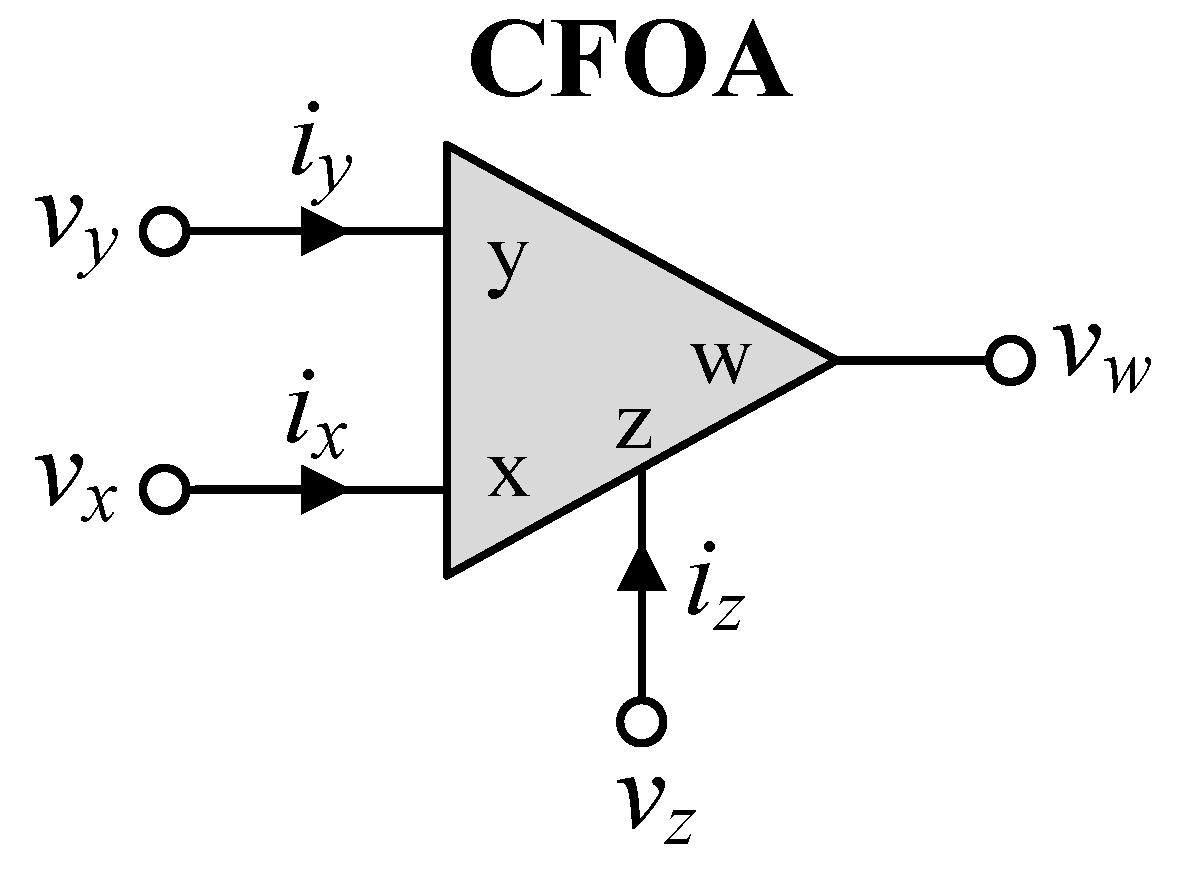



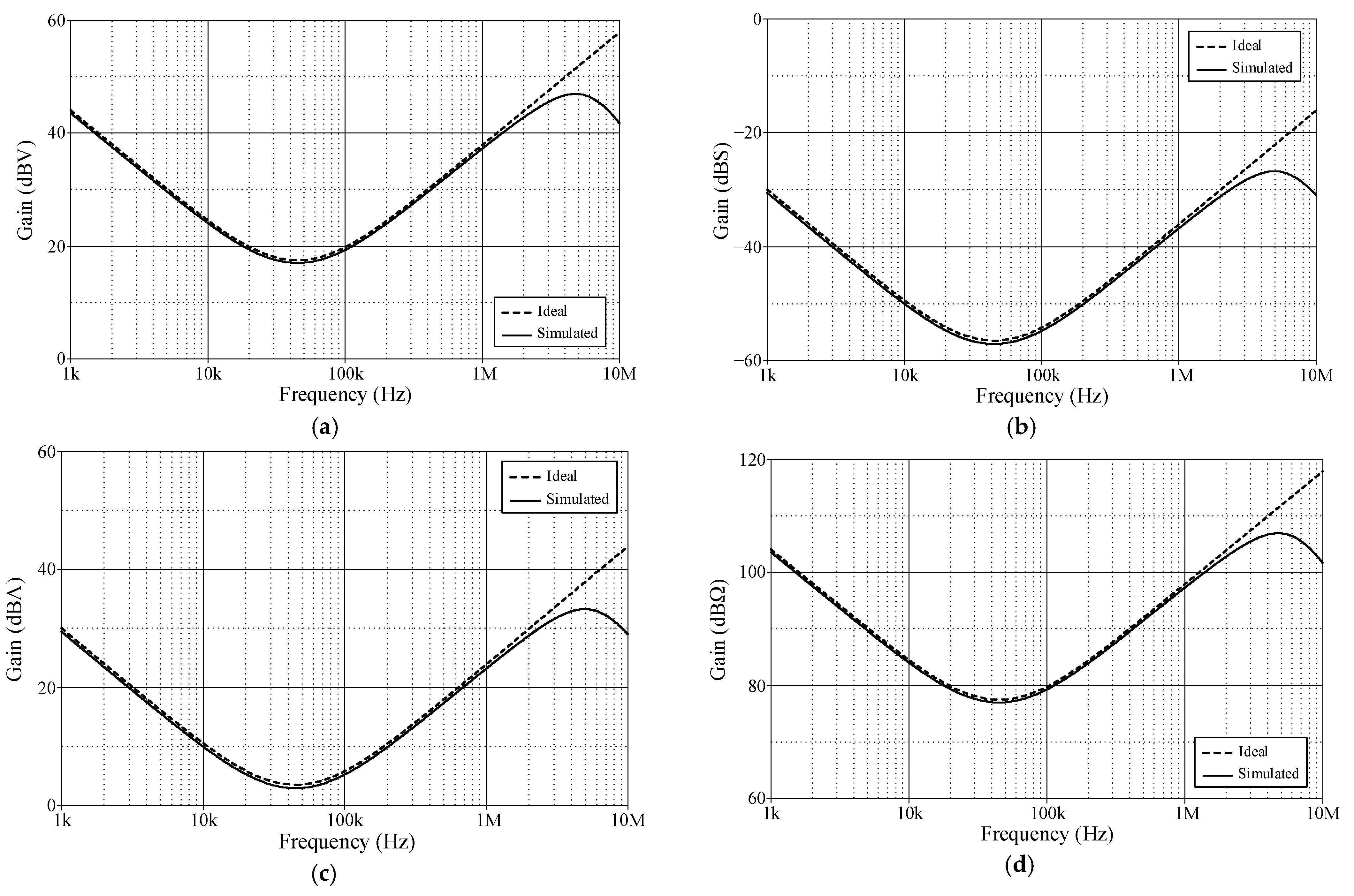

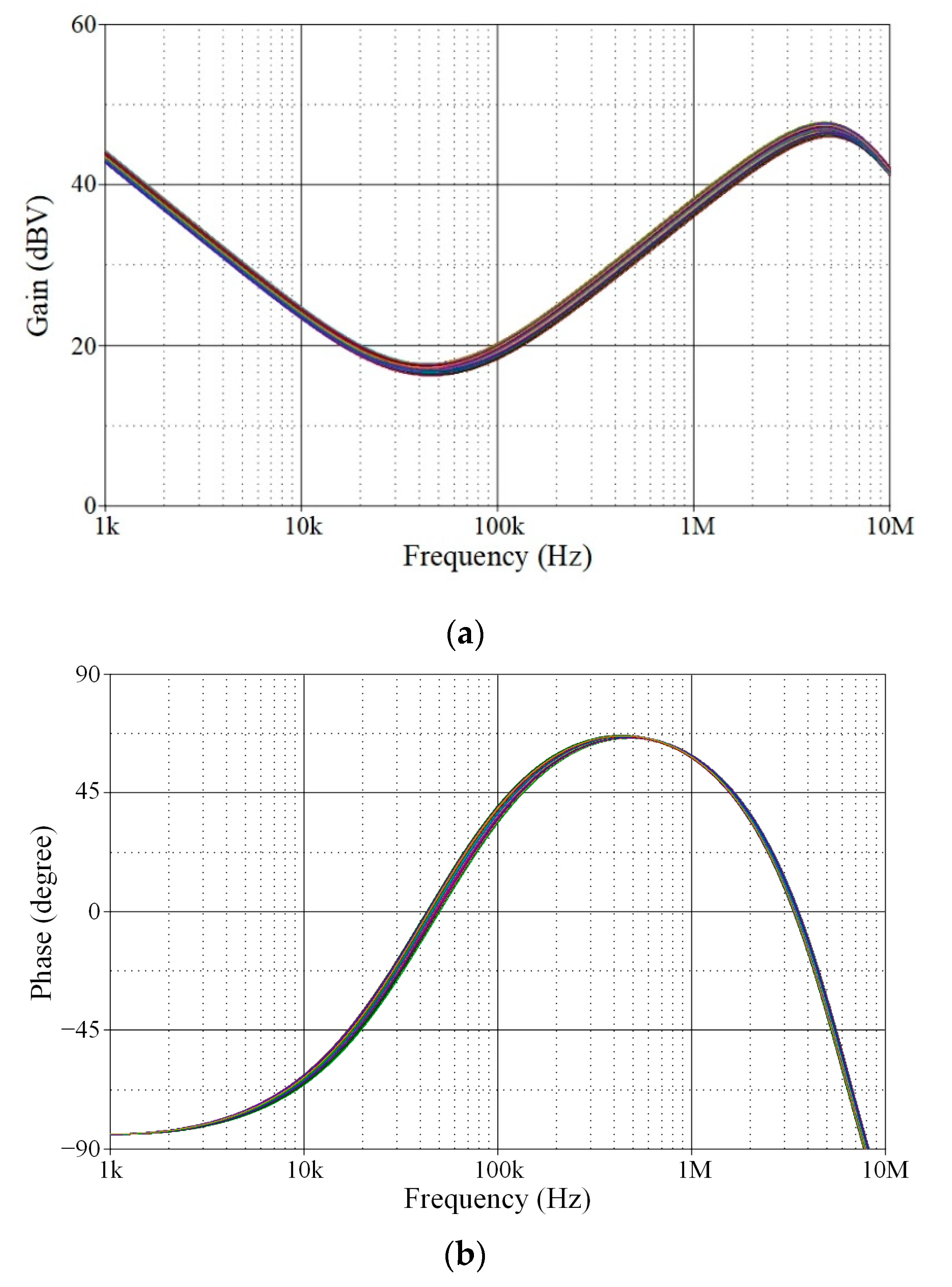
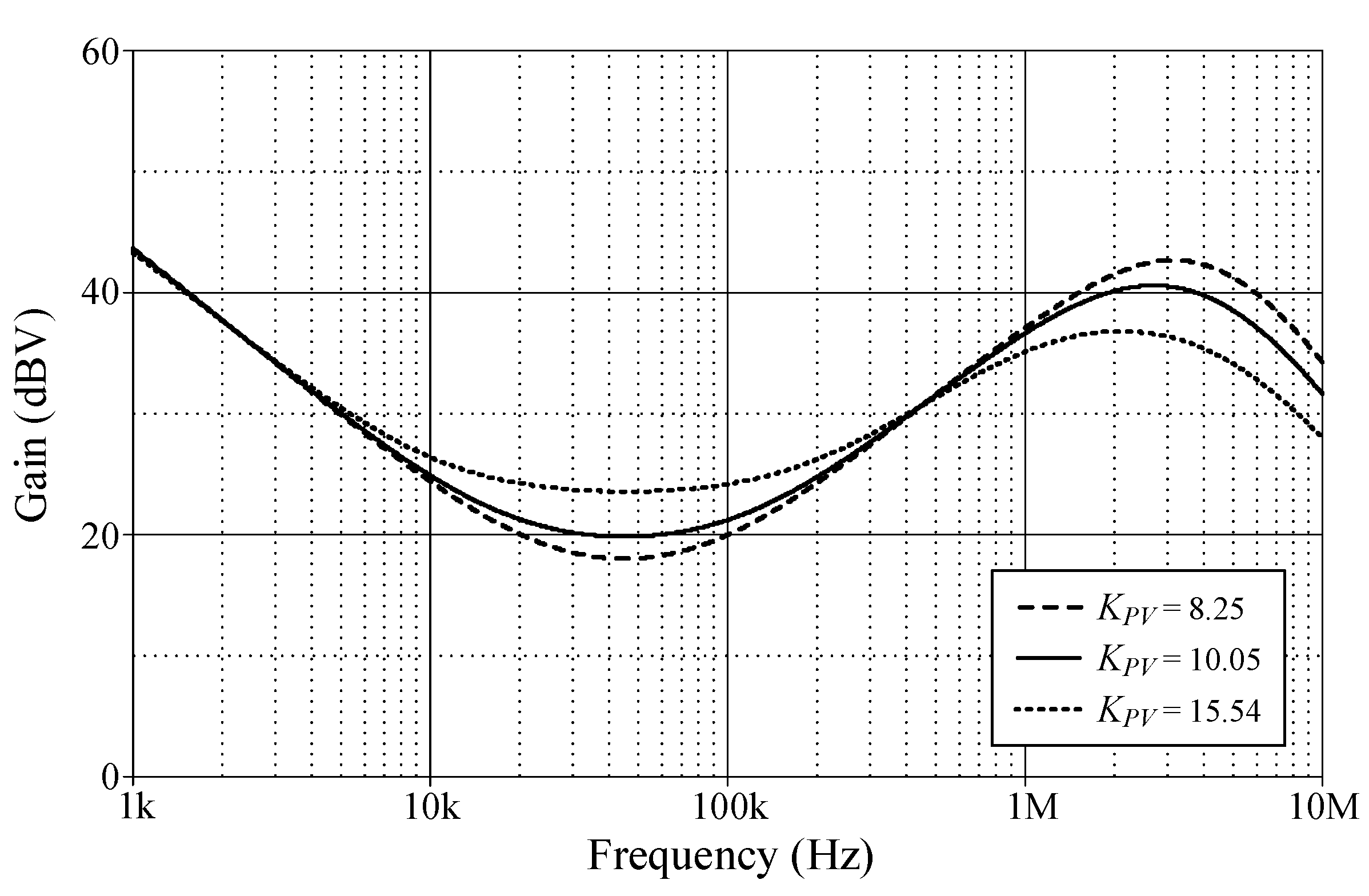



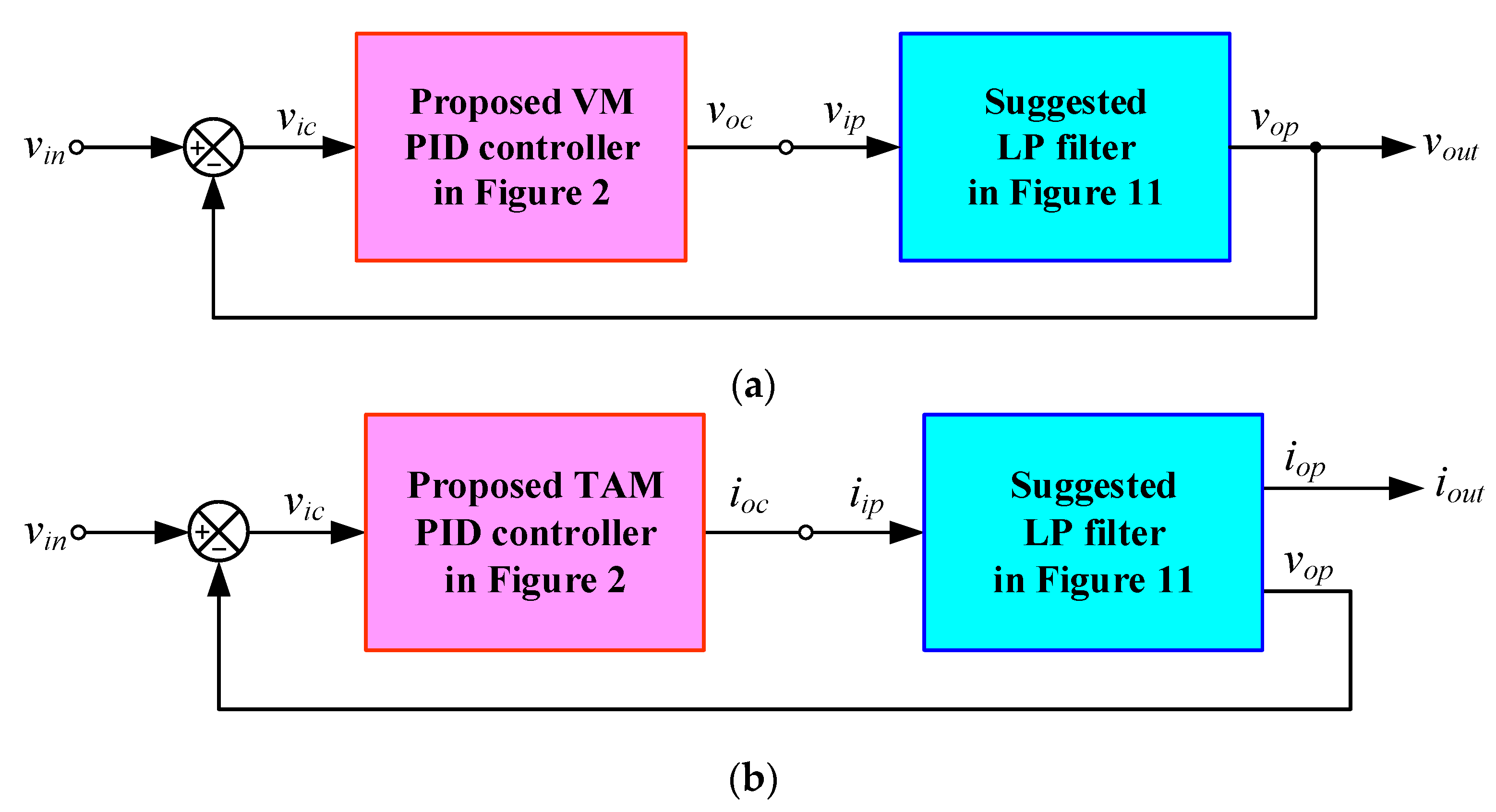

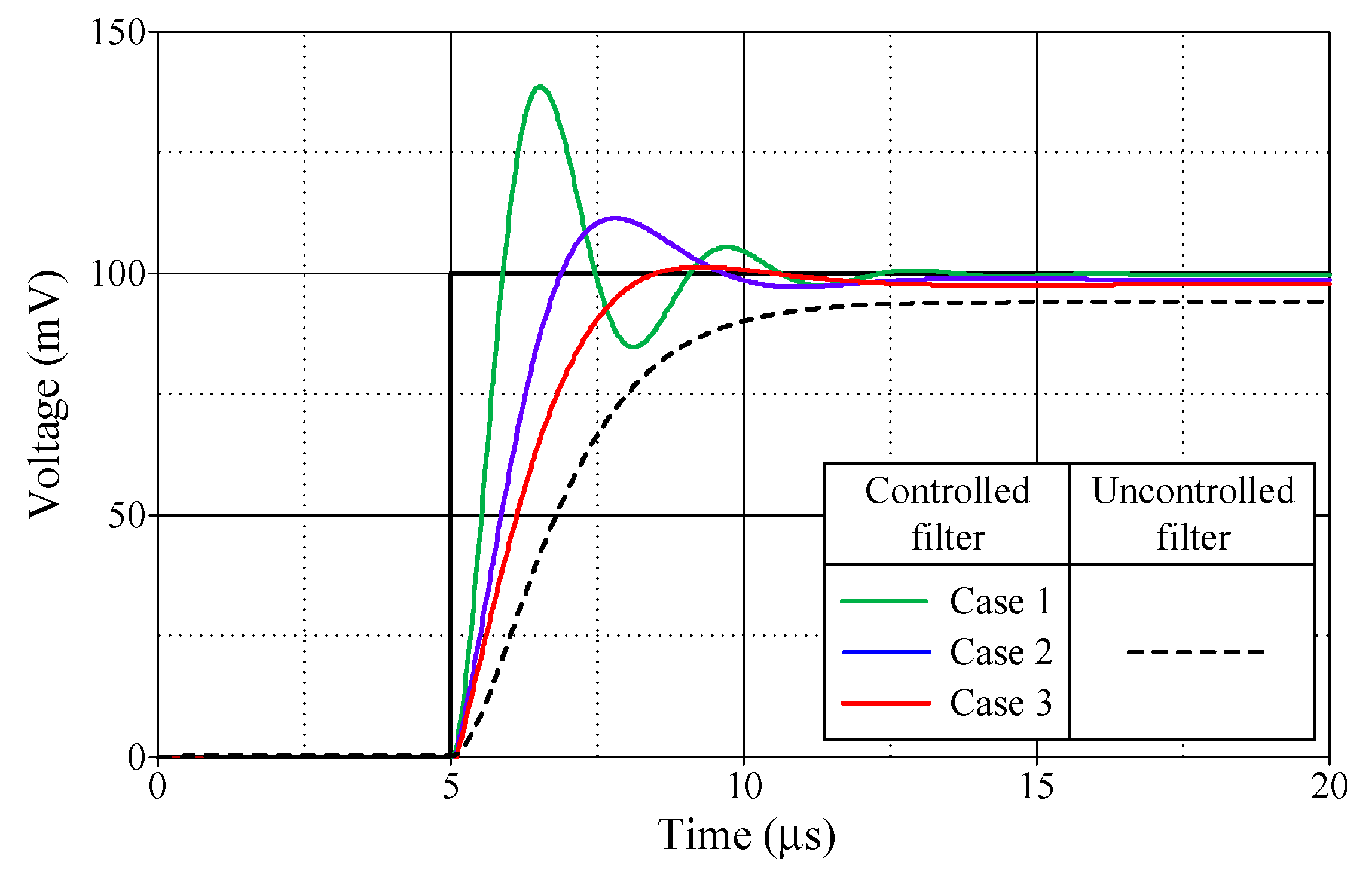
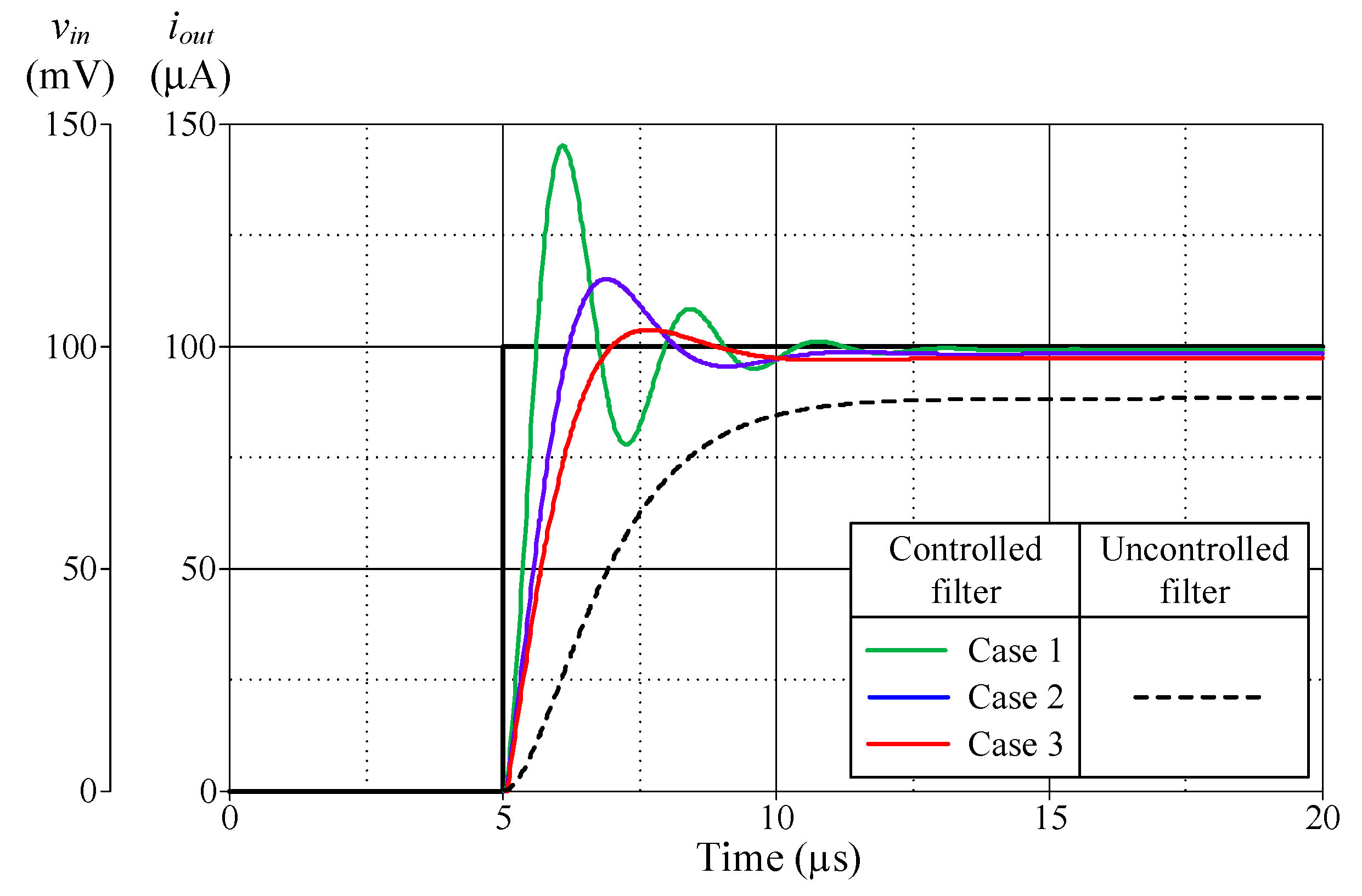


| Ref. | Active Component | Passive Component | Mixed-Mode Operation | Operating Modes | Technology | Supply Voltage (V) | |||
|---|---|---|---|---|---|---|---|---|---|
| VM | CM | TAM | TIM | ||||||
| [4] | OA = 4 | R = 8, C = 2 | no | yes | no | no | no | NA | NA |
| [5] | OTA = 8 | C = 2 | no | yes | no | no | no | 0.8-μm AMS | ±5, (−2~4) |
| [6] | CDBA = 4 | R = 8, C = 2 | no | yes | no | no | no | 0.8-μm AMS | ±2.5, ±1 |
| [7] | OTRA = 2 | R = 4, C = 3 | no | yes | no | no | no | 0.18-μm MOSIS | ±1.5 |
| [8] | CCII = 2 | R = 4, C = 2 | no | yes | yes | no | no | AD844 | NA |
| [9] | CCII = 1, DO-CCII = 1 | R = 3, C = 2 | no | yes | yes | no | no | 0.35-μm TSMC | ±1.5, +0.5 |
| [10] | DO-CCII = 1 | R = 2, C = 2 | no | no | yes | no | no | 0.13-μm CMOS | ±1, +0.4 |
| [11] | VDCC = 1 | R = 4, C = 2 | no | yes | no | no | no | 0.18-μm CMOS | ±0.9 |
| [12] | DVCCTA = 1 | R = 3, C = 2 | no | yes | no | no | no | 0.25-μm TSMC | ±1.5, −1 |
| [13] | DDCC = 3 | R = 3, C = 2 | no | yes | no | no | no | 0.13-μm IBM | ±0.75, +0.37 |
| [14] | ZC-CFTA = 1 | R = 2, C = 2 | no | yes | no | no | no | 0.35-μm BiCMOS | ±1 |
| [15] | CCTA = 1 | R = 2, C = 2 | no | yes | no | no | no | 0.35-μm TSMC | ±1.5 |
| [16] | CFOA = 2 | R = 3, C = 2 for VM, R = 5, C = 2 for CM | no | yes | yes | no | no | AD844 | ±12 |
| [17] | Transconductor = 6 | C = 2 | yes | yes | yes | yes | yes | 0.18-μm TSMC | ±0.9 |
| [18] | CFOA = 1 | R = 2, C = 2 | no | yes | no | no | no | 0.18-μm TSMC | ±2 |
| [19] | CFOA = 2 | R = 2, C = 2 for CM (Figure 3) | no | no | yes | no | no | 0.18-μm TSMC | ±2 |
| R = 4, C = 2 for MM, (Figure 4) | yes | yes | yes | yes | yes | ||||
| Proposed controller | CFOA = 3 | R = 4, C = 2 | yes | yes | yes | yes | yes | AD844 | ±9 |
| Temperature (°C) | Controller VM Gain (dBV) | ||
|---|---|---|---|
| f = 10 kHz | f = 100 kHz | f = 1 MHz | |
| 0 | 24.090 | 19.350 | 37.336 |
| 25 | 24.056 | 19.315 | 37.293 |
| 50 | 24.021 | 19.281 | 37.249 |
| 75 | 23.987 | 19.246 | 37.204 |
| 100 | 23.953 | 19.212 | 37.157 |
| KPV | KIV (Ms−1) | KDV (μs) | R0 (kΩ) | R1 = R2 = R3 (kΩ) | C1 (nF) | C2 (nF) |
|---|---|---|---|---|---|---|
| 8.25 | 1 | 12.5 | 2.5 | 5 | 0.40 | 2.5 |
| 10.05 | 3.5 | 5 | 0.29 | 3.5 | ||
| 15.54 | 6.0 | 5 | 0.17 | 6.0 |
| KPV | KIV (Ms−1) | KDV (μs) | R0 (kΩ) | R1 = R2 = R3 (kΩ) | C1 (nF) | C2 (nF) |
|---|---|---|---|---|---|---|
| 7.5 | 0.89 | 12.5 | 2.5 | 5 | 0.45 | 2.5 |
| 0.70 | 3.5 | 5 | 0.41 | 3.5 | ||
| 0.44 | 6.0 | 5 | 0.38 | 6.0 |
| KPV | KIV (Ms−1) | KDV (μs) | R0 (kΩ) | R1 = R2 = R3 (kΩ) | C1 (nF) | C2 (nF) |
|---|---|---|---|---|---|---|
| 3 | 0.4 | 5.61 | 3.5 | 5 | 0.72 | 1.57 |
| 4.52 | 6 | 5 | 0.42 | 2.17 | ||
| 3.13 | 10 | 5 | 0.25 | 2.50 |
| R0 = R2 (kΩ) | KPV | KIV (Ms−1) | KDV (μs) | Delay Time, td (μs) | Rise Time, tr (μs) | Peak Time, tp (μs) | Settling Time, ts (μs) | Maximum Overshoot, Mp (mV) | Steady- State Error (mV) | |||
|---|---|---|---|---|---|---|---|---|---|---|---|---|
| 5% | 2% | |||||||||||
| PID- controlled filter | Case 1 | 1 | 5.50 | 5.00 | 0.5 | 5.52 | 5.89 | 6.53 | 9.97 | 11.52 | 138.63 | 0.20 |
| Case 2 | 3 | 2.17 | 1.67 | 0.5 | 5.86 | 6.88 | 7.81 | 9.06 | 9.52 | 111.43 | 1.19 | |
| Case 3 | 5 | 1.50 | 1.00 | 0.5 | 6.12 | 8.50 | 9.28 | 7.66 | 10.66 | 101.40 | 2.19 | |
| Uncontrolled filter | 6.79 | 11.69 | 11.69 | 9.72 | 10.83 | 94.19 | 5.81 | |||||
| R0 = R2 (kΩ) | KPY | KIY (Ms−1) | KDY (μs) | Delay Time, td (μs) | Rise Time, tr (μs) | Peak Time, tp (μs) | Settling Time, ts (μs) | Maximum Overshoot, Mp (μA) | Steady- State Error (μA) | |||
|---|---|---|---|---|---|---|---|---|---|---|---|---|
| 5% | 2% | |||||||||||
| PID- controlled filter | Case 1 | 1 | 11 | 10 | 1 | 5.36 | 5.61 | 6.09 | 8.83 | 10.04 | 145.23 | 0.72 |
| Case 2 | 3 | 4.33 | 3.33 | 1 | 5.56 | 6.21 | 6.89 | 7.92 | 9.64 | 115.20 | 1.68 | |
| Case 3 | 5 | 3 | 2 | 1 | 5.69 | 6.98 | 7.68 | 8.28 | 9.09 | 103.76 | 2.63 | |
| Uncontrolled filter | 6.92 | 14.30 | 14.30 | 9.64 | 10.76 | 88.36 | 11.64 | |||||
| R0 = R2 (kΩ) | KPI | KII (Ms−1) | KDI (μs) | Delay Time, td (μs) | Rise Time, tr (μs) | Peak Time, tp (μs) | Settling Time, ts (μs) | Maximum Overshoot, Mp (μA) | Steady- State Error (μA) | |||
|---|---|---|---|---|---|---|---|---|---|---|---|---|
| 5% | 2% | |||||||||||
| PID- controlled filter | Case 1 | 1 | 1.1 | 1 | 0.1 | 5.52 | 5.89 | 6.53 | 9.99 | 11.45 | 138.92 | 0.10 |
| Case 2 | 3 | 1.3 | 1 | 0.3 | 5.83 | 6.81 | 7.80 | 9.06 | 9.51 | 113.53 | 0.90 | |
| Case 3 | 5 | 1.5 | 1 | 0.5 | 6.03 | 7.98 | 9.26 | 7.66 | 10.66 | 105.29 | 1.71 | |
| Uncontrolled filter | 6.81 | 11.63 | 11.63 | 9.72 | 10.83 | 93.74 | 6.26 | |||||
| R0 = R2 (kΩ) | KPZ | KIZ (Ms−1) | KDZ (μs) | Delay time, td (μs) | Rise Time, tr (μs) | Peak Time, tp (μs) | Settling Time, ts (μs) | Maximum Overshoot, Mp (mV) | Steady- State Error (mV) | |||
|---|---|---|---|---|---|---|---|---|---|---|---|---|
| 5% | 2% | |||||||||||
| PID- controlled filter | Case 1 | 1 | 5.50 | 5 | 0.5 | 5.54 | 5.92 | 6.59 | 10.06 | 11.62 | 138.03 | 0.001 |
| Case 2 | 3 | 6.5 | 5 | 1.5 | 5.87 | 6.91 | 7.91 | 9.19 | 9.67 | 112.82 | 0.782 | |
| Case 3 | 5 | 7.5 | 5 | 2.5 | 6.09 | 8.13 | 9.51 | 7.81 | 10.79 | 104.79 | 1.579 | |
| Uncontrolled filter | 6.70 | 11.81 | 11.81 | 9.79 | 10.91 | 99.92 | 0.085 | |||||
Disclaimer/Publisher’s Note: The statements, opinions and data contained in all publications are solely those of the individual author(s) and contributor(s) and not of MDPI and/or the editor(s). MDPI and/or the editor(s) disclaim responsibility for any injury to people or property resulting from any ideas, methods, instructions or products referred to in the content. |
© 2024 by the authors. Licensee MDPI, Basel, Switzerland. This article is an open access article distributed under the terms and conditions of the Creative Commons Attribution (CC BY) license (https://creativecommons.org/licenses/by/4.0/).
Share and Cite
Roongmuanpha, N.; Satansup, J.; Pukkalanun, T.; Tangsrirat, W. Design of Mixed-Mode Analog PID Controller with CFOAs. Sensors 2024, 24, 3125. https://doi.org/10.3390/s24103125
Roongmuanpha N, Satansup J, Pukkalanun T, Tangsrirat W. Design of Mixed-Mode Analog PID Controller with CFOAs. Sensors. 2024; 24(10):3125. https://doi.org/10.3390/s24103125
Chicago/Turabian StyleRoongmuanpha, Natchanai, Jetsdaporn Satansup, Tattaya Pukkalanun, and Worapong Tangsrirat. 2024. "Design of Mixed-Mode Analog PID Controller with CFOAs" Sensors 24, no. 10: 3125. https://doi.org/10.3390/s24103125
APA StyleRoongmuanpha, N., Satansup, J., Pukkalanun, T., & Tangsrirat, W. (2024). Design of Mixed-Mode Analog PID Controller with CFOAs. Sensors, 24(10), 3125. https://doi.org/10.3390/s24103125






